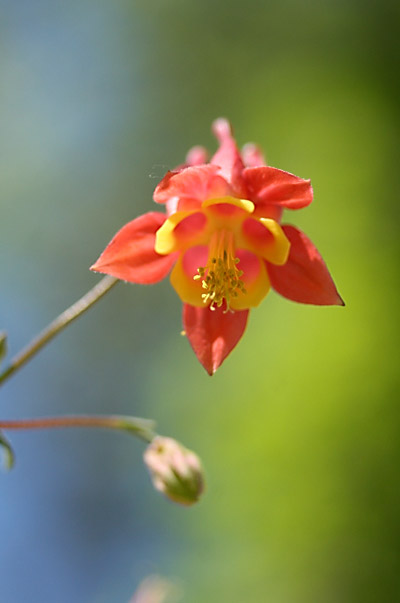 I have an idea: let’s all pretend that we are not getting unseasonably cold weather after the spring rebirth has begun, and that the temperatures are remaining exactly where they should be. In fact, let’s insist on it, in ALL CAPS if need be – it seems to work for religious folk…
I have an idea: let’s all pretend that we are not getting unseasonably cold weather after the spring rebirth has begun, and that the temperatures are remaining exactly where they should be. In fact, let’s insist on it, in ALL CAPS if need be – it seems to work for religious folk…
So naturally with such wonderful conditions, I got out a couple of times this weekend to do some shooting, not at all hampered by things like slow and interrupted blooming and frost warnings. And while the area surrounding this columbine flower (Aquilegia canadensis) was simply bursting with green undergrowth that would have made an excellent background, I chose instead to lay flat on the ground and shoot upwards into the blossom to gain a perspective that isn’t seen often, taking advantage of the blue sky and a vine-shrouded tree. Had I been thinking harder about it, I would have popped some fill flash or positioned something as a reflector to get a little more light up in there – it’s not bad as it is, but it might have made the colors shine just a bit better. I have to be careful about that with red flowers and this camera body (Canon 30D,) however – for some reason it tends to oversaturate reds and produce some unrealistic effects at times.
I ended up in three different locations over the course of two days. This columbine shot was done at the NC Botanical Gardens, same with the green treefrog two posts back, but earlier that same day I’d done a trip down to Jordan Lake to check on conditions and try to find some mantis egg cases to set up for their eventual hatching. No luck on the egg cases, and in fact I didn’t see much of anything, but a flooded area bordering some woods was playing host to a stunning number of water beetles, likely the same kind seen here (and thus probably Hydrophilidae.) I’d never noticed such behavior before, but a large number of the beetles had paused in their manic boating and were perched on twigs, looking remarkably like turtles sunning themselves on floating logs. I promise to capture a few at some point and do detailed closeups of them – it may be challenging, because like water striders, they’re very wary of close approaches and I will probably need a long-handled net, as well as quick reflexes, to snag them.
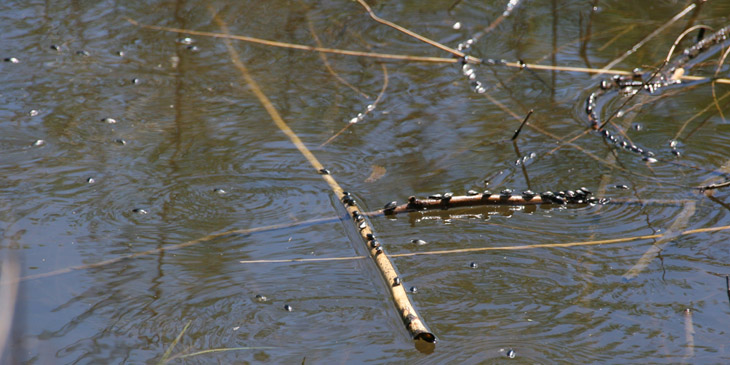
 That was about it for Jordan Lake, at least the area that I checked out, save for a lot of wisteria that was still hanging on. Wisteria tends to peak and disappear quickly, and most of what I saw was just passing optimum appearance, starting to wilt and turn brownish in places, but it was still better than my immediate area where all such blooms have already disappeared. So for this shot, we return to the Botanical Garden and take another upward view, this time a white rose against a brilliantly deep blue sky. I did a couple of compositions, both with and without the cloud, but selected this one because the cloud seems to complement the blossom well. I tend to shoot different perspectives and approaches for many of my subjects, not just satisfying myself but also maintaining stock for potential clients who might have different tastes than I do. In the interests of space I usually only feature the one I like the best on the blog, but it’s rare that I only have one version of any given photo. This post, for instance, illustrates the subtle differences that I might try – so does this one.
That was about it for Jordan Lake, at least the area that I checked out, save for a lot of wisteria that was still hanging on. Wisteria tends to peak and disappear quickly, and most of what I saw was just passing optimum appearance, starting to wilt and turn brownish in places, but it was still better than my immediate area where all such blooms have already disappeared. So for this shot, we return to the Botanical Garden and take another upward view, this time a white rose against a brilliantly deep blue sky. I did a couple of compositions, both with and without the cloud, but selected this one because the cloud seems to complement the blossom well. I tend to shoot different perspectives and approaches for many of my subjects, not just satisfying myself but also maintaining stock for potential clients who might have different tastes than I do. In the interests of space I usually only feature the one I like the best on the blog, but it’s rare that I only have one version of any given photo. This post, for instance, illustrates the subtle differences that I might try – so does this one.
This trip to the garden failed to net any images of the green anoles that frequent the locale, and even the frogs were pretty scarce – curiously, since (as we established above) the weather has been absolutely ideal for them. This session was with a student, and we both checked out one of the ponds for the resident common snapping turtles (Chelydra serpentina,) eventually finding one of the pair vaguely visible in the murky water. The pond is quite small, seemingly too small for two turtles of this size, but they appear to be perfectly happy with it. Let’s pause here and contemplate the thought of snapping turtles seeming in any way “happy.” Difficult to reconcile with their appearance, isn’t it?
What, you want a visual aid? Lucky for you that the other snapper was soon discovered basking on the walkway, drinking in the afternoon sunlight even though, you know, it was completely unnecessary given the marvelous temperatures.
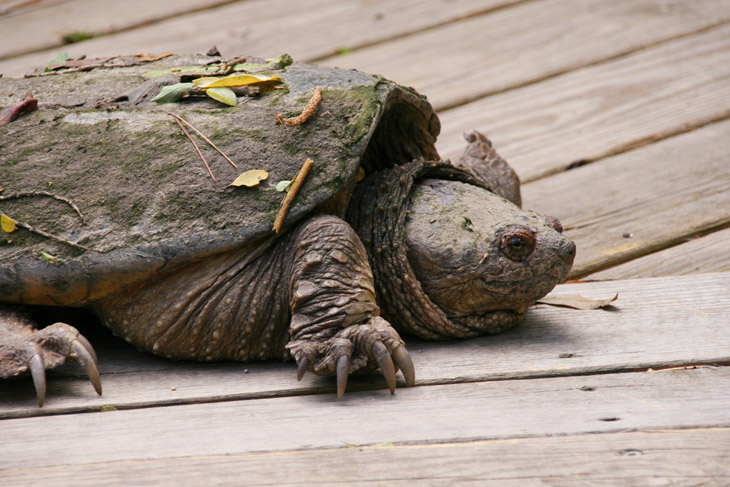
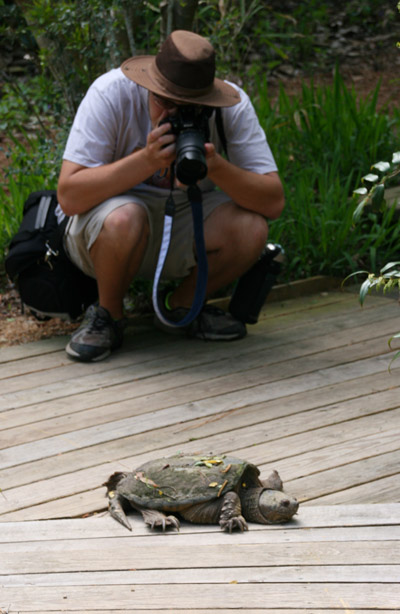 Certainly a carefree and chipper-looking species, isn’t it? You can almost picture it rolling onto its back and playing with a ball of yarn. The mud and algae on the carapace is typical of the species and its habits, only adding to the perky effect of its scaly skin and enormous claws – I think our concepts of how dinosaurs appeared have a lot to do with snapping turtles, since we have no fossil evidence of what dinosaur skin was actually like. Consider, too, how we can see images of Galápagos tortoises and find them mellow, perhaps even kindly in a geriatric way, while we cast a critical eye at snappers like this and only consider them irascible and bellicose, despite having virtually the same behavior.
Certainly a carefree and chipper-looking species, isn’t it? You can almost picture it rolling onto its back and playing with a ball of yarn. The mud and algae on the carapace is typical of the species and its habits, only adding to the perky effect of its scaly skin and enormous claws – I think our concepts of how dinosaurs appeared have a lot to do with snapping turtles, since we have no fossil evidence of what dinosaur skin was actually like. Consider, too, how we can see images of Galápagos tortoises and find them mellow, perhaps even kindly in a geriatric way, while we cast a critical eye at snappers like this and only consider them irascible and bellicose, despite having virtually the same behavior.
I should say I am referring to the prone one in the photos, and not the crouching one, which is the Inculcated Al Bugg, this time maintaining a respectful distance from his photo subject. He appears here mostly for scale, and obtained much the same kind of photos of me from his own vantage, though he has yet to forward them to me so you’ll have to use your imagination. Perhaps it’s better that way…
The following day we ventured into Duke Forest while the pleasant weather continued unabated… I’m sorry, I just can’t keep it up. It had dipped to near-freezing overnight and was still freaking chilly, making me doubt the likelihood of seeing much of anything; the area is great for water snakes at least, but only when it’s warm, and I wasn’t holding out much hope. Instead, we stuck largely to scenics, and while Mr. Bugg was working on his long-exposure techniques with moving water the proper way, with a tripod and cable release, I shot a couple of experiments handheld to see how the optical stabilization built into the lens would hold up. This is at 1/5 of a second, and not too shabby for all that.
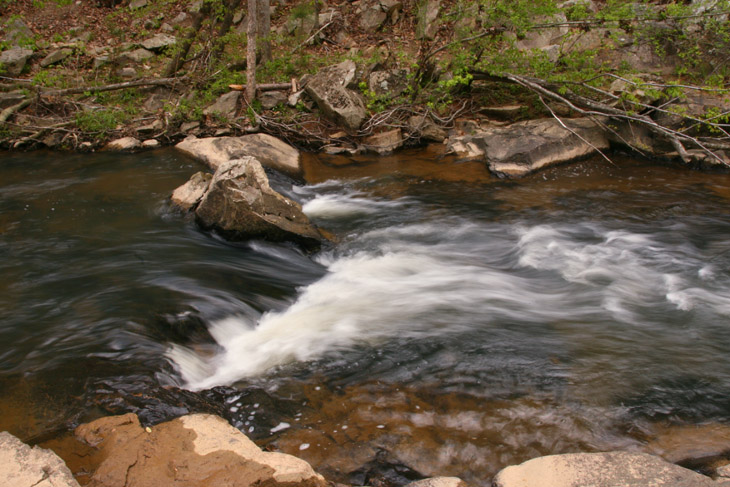
Fartistically, of course, it could be better, but I’ll wait until the foliage is much further along and I can wade into the water for an ideal vantage without inducing frostbite and gangrene.
While examining a small pool formed by higher stream levels, I discovered a newly-molted crayfish that was still soft, with its discarded exoskeleton nearby – you might see those images on Al Bugg’s blog. I also stirred up a pair of little salamanders, one of which I managed to perch in my left hand while the right handled the camera.
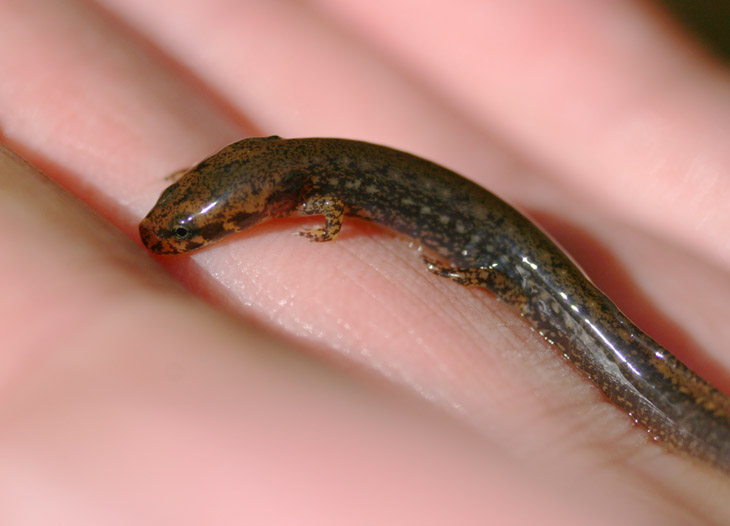
There are too many salamanders in NC to try to identify this one, especially since it’s a juvenile and bears different coloration from an adult. Suffice to say it was no more than 5cm in overall length, and able to be captured only because the pool was small enough to limit its hiding places when I stirred it up by lifting the flat stones.
It was touch-and-go on the availability of sunlight for a while, starting out near-overcast and developing into scattered clouds that would change the lighting abruptly in either direction – this stopped me several times as I positioned myself for an interesting image in sunlight, only to watch it vanish in seconds as a cloud moved in, whereupon I would peer at the sky and judge which way the cloud was moving to determine whether it was worth the wait. Doing long-exposure water pics is better with the clouds, however, since the sunlight brings bright reflections off of the splashing water, little points of white that take away from the smooth and smokey appearance of the rapids. As the clouds finally cleared for good and the day began to get warmer, it stirred up the wind, at times none too gently – I had to start using the chin-strap on my hat to retain it, and was a little surprised not to hear more limbs dropping in the thicker forest that surrounded us, despite how deep the valley was.
 Immediately before we had to wrap it up for the session, we finally found one of the subjects we’d come down to see, a northern water snake (Nerodia sipedon.) They can often be observed right near the concrete apron where the gravel access road crosses the river – the jumble of rocks and frequent jams of dead trees brought by the currents make an ideal habitat, good hiding places while convenient to the water. This one had found a nice spot, fully exposed to the warming sunlight while sheltered from both the wind and casual observation. I actually compared the markings on this one against the one found last year not ten meters from the same location, trying to determine if they were the same individual. Answer: nope – see the markings immediately behind the heads. Not at all surprised, since plenty of them live in the area, but I’d hoped anyway. We’d spotted this one perhaps 20 minutes earlier with only its head poking from the water, so it had been basking long enough to dry out, and hopefully was warming up adequately – the temperature dropped to near-freezing once again that evening, so its window of activity was markedly brief.
Immediately before we had to wrap it up for the session, we finally found one of the subjects we’d come down to see, a northern water snake (Nerodia sipedon.) They can often be observed right near the concrete apron where the gravel access road crosses the river – the jumble of rocks and frequent jams of dead trees brought by the currents make an ideal habitat, good hiding places while convenient to the water. This one had found a nice spot, fully exposed to the warming sunlight while sheltered from both the wind and casual observation. I actually compared the markings on this one against the one found last year not ten meters from the same location, trying to determine if they were the same individual. Answer: nope – see the markings immediately behind the heads. Not at all surprised, since plenty of them live in the area, but I’d hoped anyway. We’d spotted this one perhaps 20 minutes earlier with only its head poking from the water, so it had been basking long enough to dry out, and hopefully was warming up adequately – the temperature dropped to near-freezing once again that evening, so its window of activity was markedly brief.
It’s better than snow, but I still feel a bit cheated at the spastic nature of the spring right now. Nature photographers don’t like being put on hold.



















































